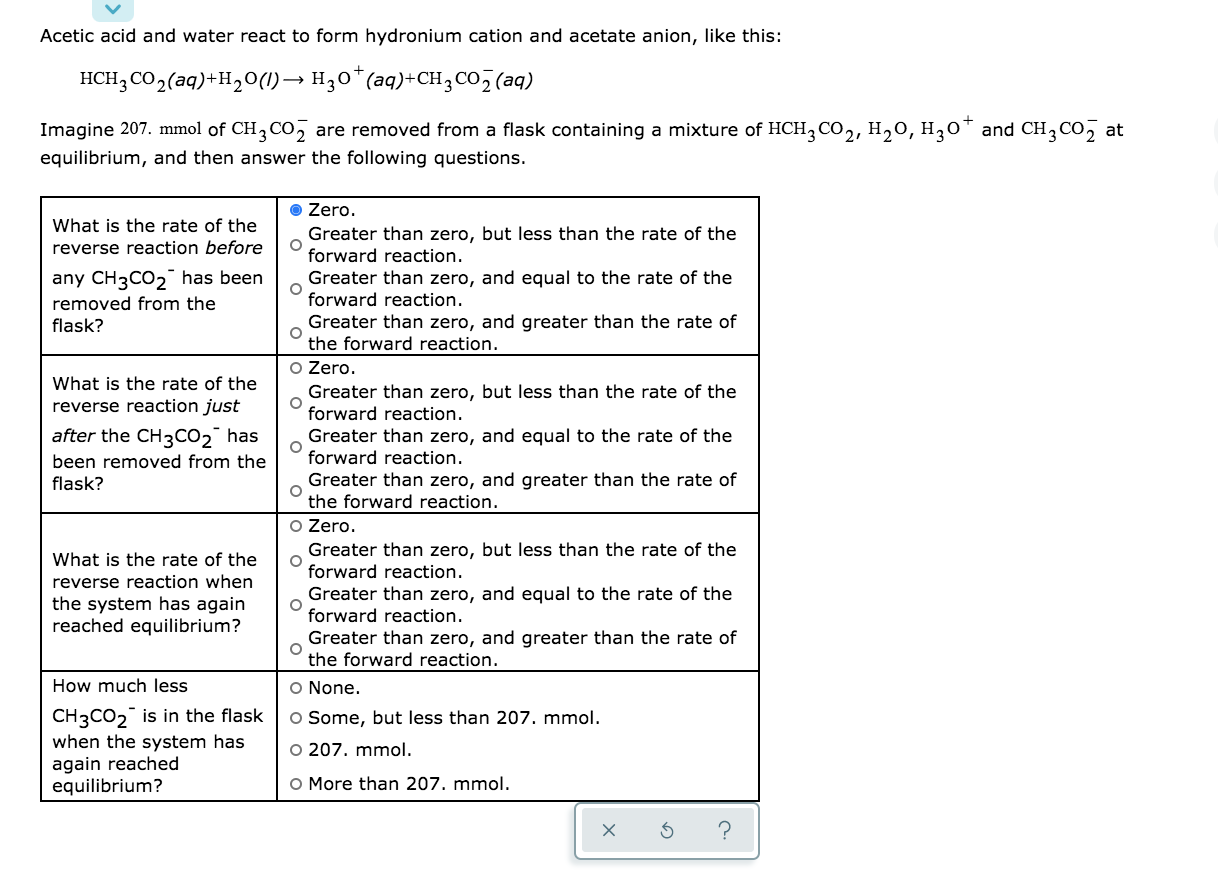Acetic acid and water react to form hydronium cation and acetate anion, like this: HCH3 CO2(aq)+H20(1)→ H30*(aq)+CH3 CO5(aq) Imagine 207. mmol of CH3 CO, are removed from a flask containing a mixture of HCH3CO2, H20, H3O* and CH3CO, at equilibrium, and then answer the following questions. O Zero. What is the rate of the Greater than zero, but less than the rate of the forward reaction. reverse reaction before any CH3CO2 has been removed from the Greater than zero, and equal to the rate of the forward reaction. Greater than zero, and greater than the rate of the forward reaction. flask? O Zero. Greater than zero, but less than the rate of the forward reaction. What is the rate of the reverse reaction just after the CH3CO2 has Greater than zero, and equal to the rate of the forward reaction. Greater than zero, and greater than the rate of the forward reaction. been removed from the flask? O Zero. Greater than zero, but less than the rate of the forward reaction. What is the rate of the reverse reaction when the system has again reached equilibrium? Greater than zero, and equal to the rate of the forward reaction. Greater than zero, and greater than the rate of the forward reaction. How much less O None. CH3CO2¯ is in the flask when the system has again reached equilibrium? O Some, but less than 207. mmol. O 207. mmol. O More than 207. mmol.
Acetic acid and water react to form hydronium cation and acetate anion, like this: HCH3 CO2(aq)+H20(1)→ H30*(aq)+CH3 CO5(aq) Imagine 207. mmol of CH3 CO, are removed from a flask containing a mixture of HCH3CO2, H20, H3O* and CH3CO, at equilibrium, and then answer the following questions. O Zero. What is the rate of the Greater than zero, but less than the rate of the forward reaction. reverse reaction before any CH3CO2 has been removed from the Greater than zero, and equal to the rate of the forward reaction. Greater than zero, and greater than the rate of the forward reaction. flask? O Zero. Greater than zero, but less than the rate of the forward reaction. What is the rate of the reverse reaction just after the CH3CO2 has Greater than zero, and equal to the rate of the forward reaction. Greater than zero, and greater than the rate of the forward reaction. been removed from the flask? O Zero. Greater than zero, but less than the rate of the forward reaction. What is the rate of the reverse reaction when the system has again reached equilibrium? Greater than zero, and equal to the rate of the forward reaction. Greater than zero, and greater than the rate of the forward reaction. How much less O None. CH3CO2¯ is in the flask when the system has again reached equilibrium? O Some, but less than 207. mmol. O 207. mmol. O More than 207. mmol.
Chemistry for Engineering Students
4th Edition
ISBN:9781337398909
Author:Lawrence S. Brown, Tom Holme
Publisher:Lawrence S. Brown, Tom Holme
Chapter5: Gases
Section: Chapter Questions
Problem 5.105PAE: 105 The decomposition of mercury(II) thiocyanate produces an odd brown snake-like mass that is so...
Related questions
Question

Transcribed Image Text:Acetic acid and water react to form hydronium cation and acetate anion, like this:
HCH3 CO2(aq)+H20(1)→ H30*(aq)+CH3 CO5(aq)
Imagine 207. mmol of CH3 CO, are removed from a flask containing a mixture of HCH3CO2, H20, H3O* and CH3CO, at
equilibrium, and then answer the following questions.
O Zero.
What is the rate of the
Greater than zero, but less than the rate of the
forward reaction.
reverse reaction before
any CH3CO2 has been
removed from the
Greater than zero, and equal to the rate of the
forward reaction.
Greater than zero, and greater than the rate of
the forward reaction.
flask?
O Zero.
Greater than zero, but less than the rate of the
forward reaction.
What is the rate of the
reverse reaction just
after the CH3CO2 has
Greater than zero, and equal to the rate of the
forward reaction.
Greater than zero, and greater than the rate of
the forward reaction.
been removed from the
flask?
O Zero.
Greater than zero, but less than the rate of the
forward reaction.
What is the rate of the
reverse reaction when
the system has again
reached equilibrium?
Greater than zero, and equal to the rate of the
forward reaction.
Greater than zero, and greater than the rate of
the forward reaction.
How much less
O None.
CH3CO2¯ is in the flask
when the system has
again reached
equilibrium?
O Some, but less than 207. mmol.
O 207. mmol.
O More than 207. mmol.
Expert Solution
This question has been solved!
Explore an expertly crafted, step-by-step solution for a thorough understanding of key concepts.
This is a popular solution!
Trending now
This is a popular solution!
Step by step
Solved in 4 steps

Knowledge Booster
Learn more about
Need a deep-dive on the concept behind this application? Look no further. Learn more about this topic, chemistry and related others by exploring similar questions and additional content below.Recommended textbooks for you

Chemistry for Engineering Students
Chemistry
ISBN:
9781337398909
Author:
Lawrence S. Brown, Tom Holme
Publisher:
Cengage Learning

Chemistry
Chemistry
ISBN:
9781305957404
Author:
Steven S. Zumdahl, Susan A. Zumdahl, Donald J. DeCoste
Publisher:
Cengage Learning

Chemistry: An Atoms First Approach
Chemistry
ISBN:
9781305079243
Author:
Steven S. Zumdahl, Susan A. Zumdahl
Publisher:
Cengage Learning

Chemistry for Engineering Students
Chemistry
ISBN:
9781337398909
Author:
Lawrence S. Brown, Tom Holme
Publisher:
Cengage Learning

Chemistry
Chemistry
ISBN:
9781305957404
Author:
Steven S. Zumdahl, Susan A. Zumdahl, Donald J. DeCoste
Publisher:
Cengage Learning

Chemistry: An Atoms First Approach
Chemistry
ISBN:
9781305079243
Author:
Steven S. Zumdahl, Susan A. Zumdahl
Publisher:
Cengage Learning


Chemistry by OpenStax (2015-05-04)
Chemistry
ISBN:
9781938168390
Author:
Klaus Theopold, Richard H Langley, Paul Flowers, William R. Robinson, Mark Blaser
Publisher:
OpenStax

Chemistry: The Molecular Science
Chemistry
ISBN:
9781285199047
Author:
John W. Moore, Conrad L. Stanitski
Publisher:
Cengage Learning